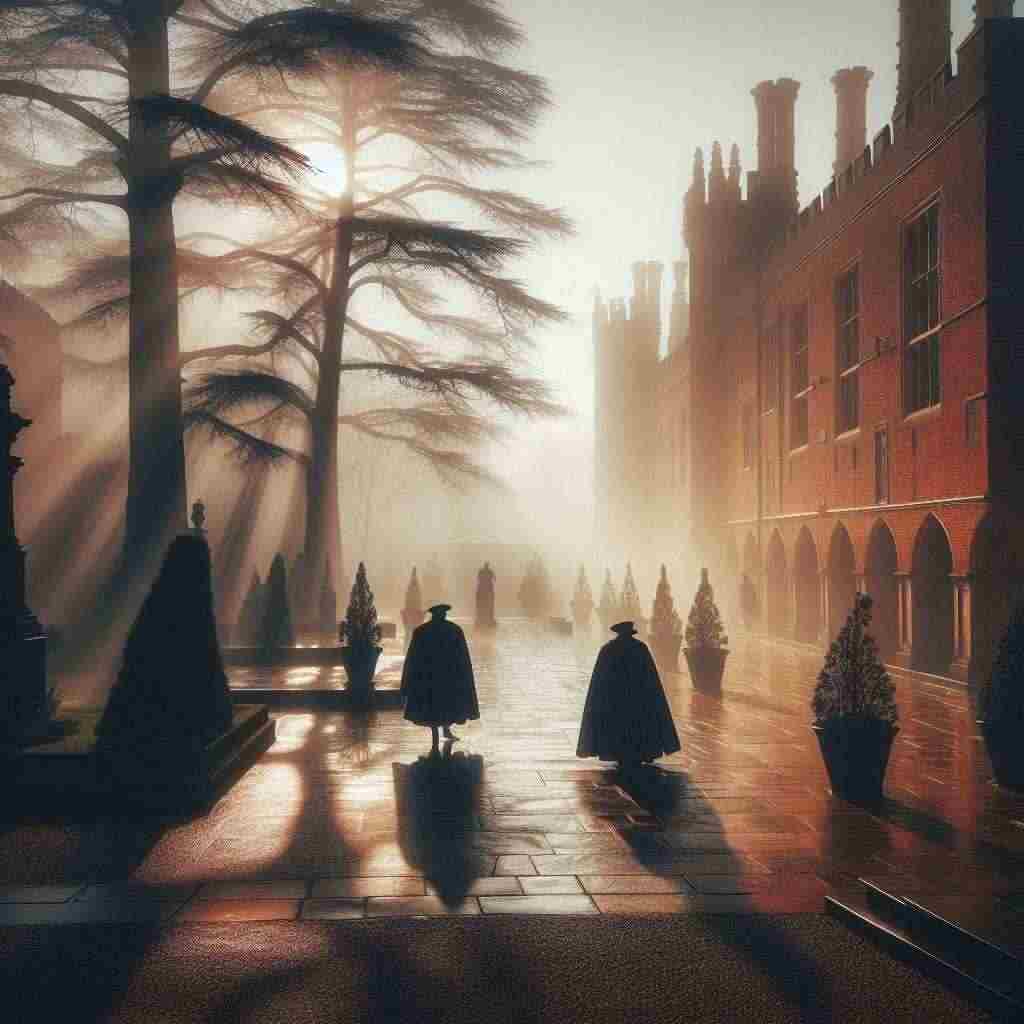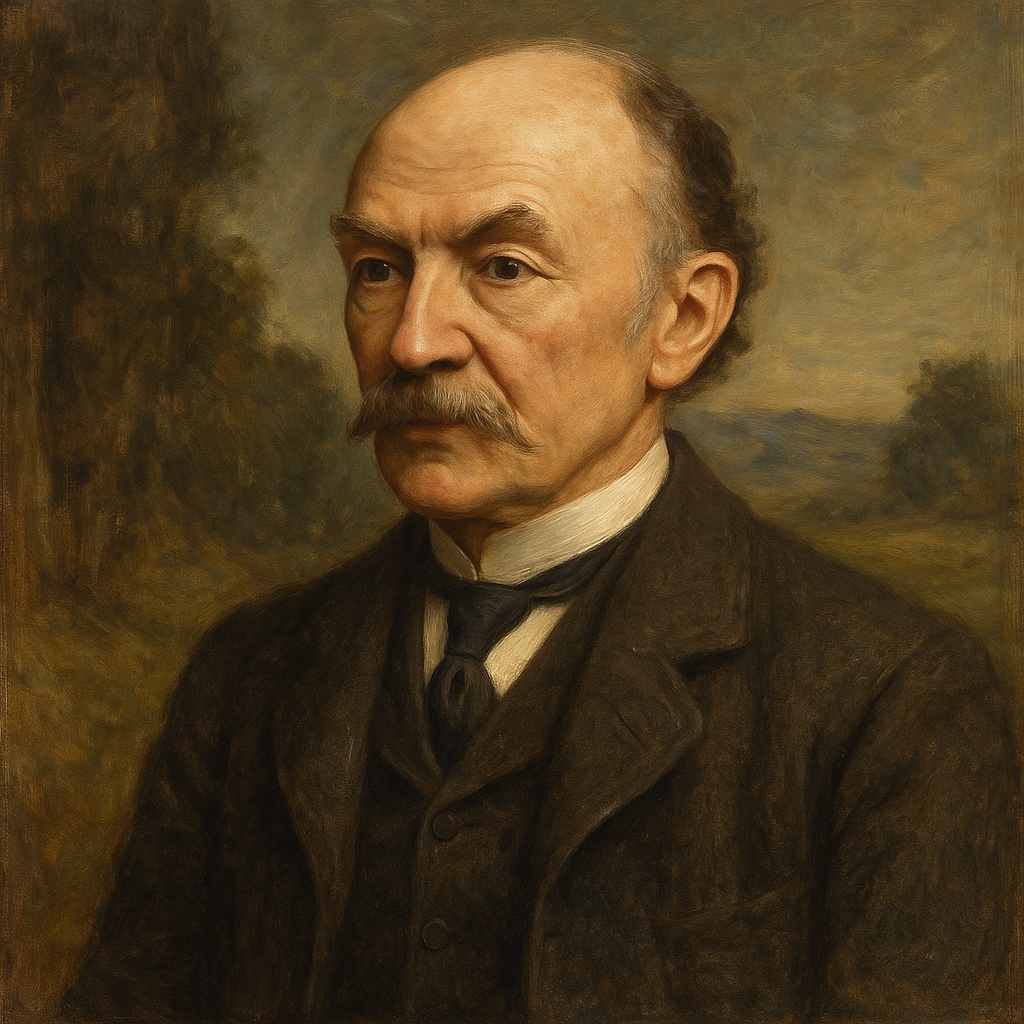A Spellbound Palace
Thomas Hardy
1840 to 1928

(Hampton Court)
On this kindly yellow day of mild low-travelling winter sun
The stirless depths of the yews
Are vague with misty blues:
Across the spacious pathways stretching spires of shadow run,
And the wind-gnawed walls of ancient brick are fired vermilion.
Two or three early sanguine finches tune
Some tentative strains, to be enlarged by May or June:
From a thrush or blackbird
Comes now and then a word,
While an enfeebled fountain somewhere within is heard.
Our footsteps wait awhile,
Then draw beneath the pile,
When an inner court outspreads
As 'twere History's own asile,
Where the now-visioned fountain its attenuate crystal sheds
In passive lapse that seems to ignore the yon world's clamorous clutch,
And lays an insistent numbness on the place, like a cold hand's touch.
And there swaggers the Shade of a straddling King, plumed, sworded, with sensual face,
And lo, too, that of his Minister, at a bold self-centred pace:
Sheer in the sun they pass; and thereupon all is still,
Save the mindless fountain tinkling on with thin enfeebled will.
Thomas Hardy's A Spellbound Palace
Thomas Hardy's poem "A Spellbound Palace (Hampton Court)" offers a rich tapestry of imagery and historical allusion, inviting readers to explore the intersection of past and present within the confines of a historic royal residence. Through his masterful use of language and keen observational skills, Hardy creates a vivid sensory experience that transports the reader to Hampton Court Palace, while simultaneously evoking the weight of history that permeates the location.
The poem opens with a description of a winter day, characterized by "mild low-travelling winter sun" and "stirless depths of the yews." This setting immediately establishes a sense of quietude and contemplation, preparing the reader for the introspective journey that follows. The contrast between the "vague" misty blues and the "fired vermilion" of the ancient brick walls creates a visual dichotomy that mirrors the poem's thematic interplay between the present moment and historical echoes.
Hardy's attention to auditory details further enriches the sensory landscape of the poem. The "tentative strains" of finches and the occasional "word" from a thrush or blackbird provide a subtle soundtrack to the scene, while the "enfeebled fountain" serves as a persistent, if weakened, link to the past. These sonic elements contribute to the overall atmosphere of stillness and reflection, reinforcing the sense of being suspended between time periods.
As the poem progresses, Hardy guides the reader from the exterior of the palace to an inner court, described as "History's own asile." This transition marks a shift from the natural world to a more concentrated engagement with the historical essence of the place. The fountain reappears in this inner sanctum, its "attenuate crystal" creating a "passive lapse" that seems to resist the "clamorous clutch" of the outside world. This imagery suggests a space where time slows down, allowing for a more profound connection with the past.
The poem's climax arrives with the appearance of two spectral figures: the "Shade of a straddling King" and his Minister. These apparitions, likely representing Henry VIII and Cardinal Wolsey, embody the palace's most famous historical residents. Hardy's portrayal of the king as "plumed, sworded, with sensual face" efficiently captures the popular image of Henry VIII, while the Minister's "bold self-centred pace" alludes to Wolsey's notorious ambition. The brevity of their appearance - they "pass" and "thereupon all is still" - underscores the fleeting nature of power and the transience of human life when compared to the enduring presence of the palace itself.
Throughout the poem, Hardy employs a complex rhyme scheme and varied line lengths, creating a rhythmic structure that mirrors the poem's thematic exploration of time and history. The longer lines often contain more contemporary observations, while shorter lines frequently focus on historical elements, subtly reinforcing the interplay between past and present.
The final lines return to the image of the "mindless fountain," now described as "tinkling on with thin enfeebled will." This repetition creates a circular structure for the poem, emphasizing the continuous nature of time and the persistence of the past in the present moment. The fountain's diminished state can be interpreted as a metaphor for the fading of historical memory, yet its continued presence suggests that traces of the past always remain, however attenuated they may become.
In conclusion, "A Spellbound Palace" demonstrates Hardy's exceptional ability to evoke a sense of place and time through carefully crafted imagery and symbolism. The poem invites readers to contemplate the layers of history embedded in physical spaces and the complex relationship between the present moment and the echoes of the past. Through his nuanced exploration of Hampton Court Palace, Hardy creates a meditation on the nature of time, memory, and the enduring power of historical sites to captivate the imagination.
This text was generated by AI and is for reference only. Learn more
Want to join the discussion? Reopen or create a unique username to comment. No personal details required!



Comments
No comments yet. Be the first to comment!